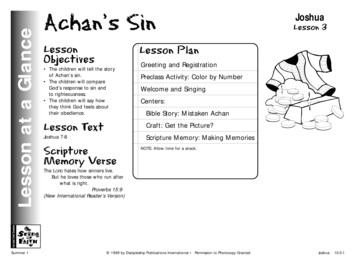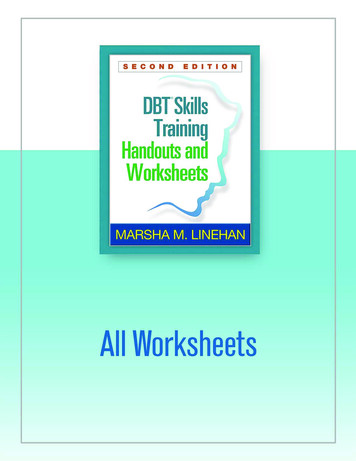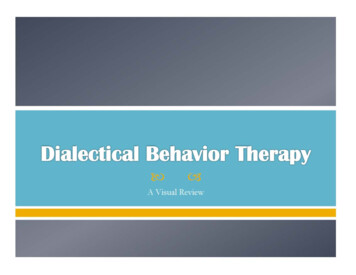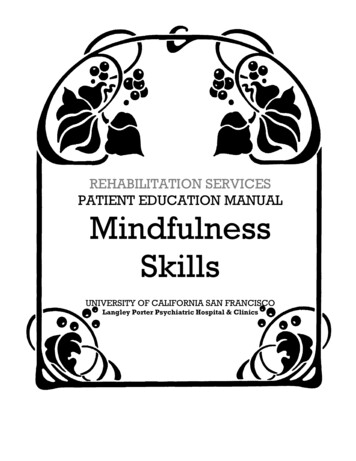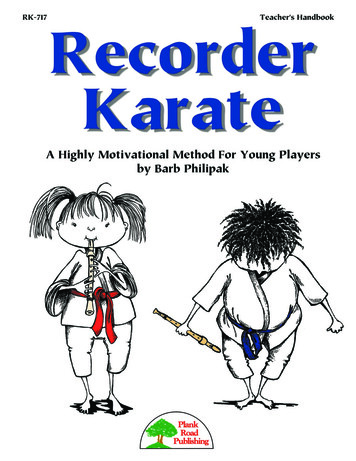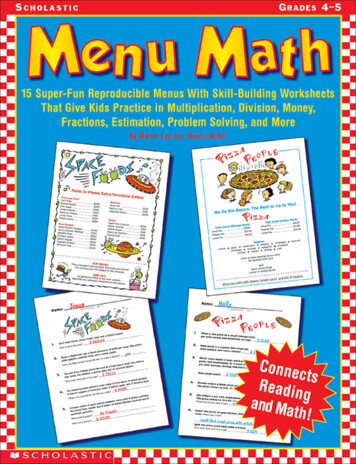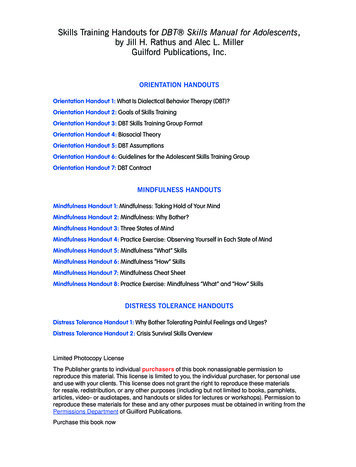
Transcription
Skills Training Handouts for DBT Skills Manual for Adolescents,by Jill H. Rathus and Alec L. MillerGuilford Publications, Inc.Orientation HandoutsOrientation Handout 1: What Is Dialectical Behavior Therapy (DBT)?Orientation Handout 2: Goals of Skills TrainingOrientation Handout 3: DBT Skills Training Group FormatOrientation Handout 4: Biosocial TheoryOrientation Handout 5: DBT AssumptionsOrientation Handout 6: Guidelines for the Adolescent Skills Training GroupOrientation Handout 7: DBT ContractMindfulness HandoutsMindfulness Handout 1: Mindfulness: Taking Hold of Your MindMindfulness Handout 2: Mindfulness: Why Bother?Mindfulness Handout 3: Three States of MindMindfulness Handout 4: Practice Exercise: Observing Yourself in Each State of MindMindfulness Handout 5: Mindfulness “What” SkillsMindfulness Handout 6: Mindfulness “How” SkillsMindfulness Handout 7: Mindfulness Cheat SheetMindfulness Handout 8: Practice Exercise: Mindfulness “What” and “How” SkillsDistress Tolerance HandoutsDistress Tolerance Handout 1: Why Bother Tolerating Painful Feelings and Urges?Distress Tolerance Handout 2: Crisis Survival Skills OverviewLimited Photocopy LicenseThe Publisher grants to individual purchasers of this book nonassignable permission toreproduce this material. This license is limited to you, the individual purchaser, for personal useand use with your clients. This license does not grant the right to reproduce these materialsfor resale, redistribution, or any other purposes (including but not limited to books, pamphlets,articles, video- or audiotapes, and handouts or slides for lectures or workshops). Permission toreproduce these materials for these and any other purposes must be obtained in writing from thePermissions Department of Guilford Publications.Purchase this book now
Distress Tolerance Handout 3: Crisis Survival Skills: Distract with “Wise Mind ACCEPTS”Distress Tolerance Handout 4: Practice Exercise: Distract with “Wise Mind ACCEPTS”Distress Tolerance Handout 5: Crisis Survival Skills: Self-Soothe with Six SensesDistress Tolerance Handout 6: Practice Exercise: Self-Soothe SkillsDistress Tolerance Handout 7: Crisis Survival Skills: IMPROVE the MomentDistress Tolerance Handout 8: Practice Exercise: IMPROVE the MomentDistress Tolerance Handout 9: Crisis Survival Skills: Pros and ConsDistress Tolerance Handout 10: Practice Exercise: Pros and ConsDistress Tolerance Handout 11: Crisis Survival Skills: TIPP Skills for Managing Extreme EmotionsDistress Tolerance Handout 12: Practice Exercise: TIPP SkillsDistress Tolerance Handout 13: Create Your Crisis Survival Kit for Home, School, or WorkDistress Tolerance Handout 14: Accepting Reality: Choices We Can MakeDistress Tolerance Handout 15: Accepting Reality: Turning the MindDistress Tolerance Handout 16: WillingnessDistress Tolerance Handout 17: Ways to Practice Accepting RealityDistress Tolerance Handout 18: Practice Exercise: Accepting RealityWalking the Middle Path HandoutsWalking the Middle Path Handout 1: Dialectics: What Is It?Walking the Middle Path Handout 2: Dialectics “How-to” GuideWalking the Middle Path Handout 3: Thinking MistakesWalking the Middle Path Handout 4: Dialectical DilemmasWalking the Middle Path Handout 5: Dialectical Dilemmas: How Does the Dilemma Applyto You?Walking the Middle Path Handout 6: What’s Typical for Adolescents and What’s Causefor Concern?Walking the Middle Path Handout 7: Practice Exercise: Thinking and Acting DialecticallyWalking the Middle Path Handout 8: ValidationWalking the Middle Path Handout 9: How Can We Validate Others?Walking the Middle Path Handout 10: How Can We Validate Ourselves?Walking the Middle Path Handout 11: Practice Exercise: Validation of Self and OthersWalking the Middle Path Handout 12: Behavior ChangeWalking the Middle Path Handout 13: Ways to Increase BehaviorsWalking the Middle Path Handout 14: Practice Exercise: Positive Reinforcement
Walking the Middle Path Handout 15: Ways to Decrease or Stop BehaviorsWalking the Middle Path Handout 16: Practice Exercise: Extinction and PunishmentEmotion Regulation HandoutsEmotion Regulation Handout 1: Taking Charge of Your Emotions: Why Bother?Emotion Regulation Handout 2: Goals of Emotion Regulation Skills TrainingEmotion Regulation Handout 3: Short List of EmotionsEmotion Regulation Handout 4: What Good Are Emotions?Emotion Regulation Handout 5: A Model of EmotionsEmotion Regulation Handout 6: A Model of Emotions with SkillsEmotion Regulation Handout 7: Practice Exercise: Observe and Describe an EmotionEmotion Regulation Handout 8: ABC PLEASE OverviewEmotion Regulation Handout 9: ACCUMULATING Positive Experiences—Short TermEmotion Regulation Handout 10: Pleasant Activities ListEmotion Regulation Handout 11: Parent–Teen Shared Pleasant Activities ListEmotion Regulation Handout 12: ACCUMULATING Positive Experiences—Long TermEmotion Regulation Handout 13: Wise Mind Values and Priorities ListEmotion Regulation Handout 14: Practice Exercise: ACCUMULATING Positive Experiencesin the Short and Long TermEmotion Regulation Handout 15: Building Mastery and Coping AheadEmotion Regulation Handout 16: PLEASE SkillsEmotion Regulation Optional Handout 16a: FOOD and Your MOODEmotion Regulation Optional Handout 16b: BEST Ways to Get REST: 12 Tips for Better SleepEmotion Regulation Handout 17: Practice Exercise: Build Mastery, Cope Ahead, andPLEASE SkillsEmotion Regulation Handout 18: The Wave Skill: Mindfulness of Current EmotionsEmotion Regulation Handout 19: Check the Facts and Problem SolvingEmotion Regulation Handout 20: Opposite Action to Change EmotionsEmotion Regulation Handout 21: Practice Exercise: Opposite ActionInterpersonal Effectiveness HandoutsInterpersonal Effectiveness Handout 1: What Is Your Goal and Priority?Interpersonal Effectiveness Handout 2: What Stops You from Achieving Your Goals?
Interpersonal Effectiveness Handout 3: Building and Maintaining Positive Relationships:GIVE SkillsInterpersonal Effectiveness Handout 4: Practice Exercise: GIVE SkillsInterpersonal Effectiveness Handout 5: Getting Someone to Do What You Want:DEAR MAN SkillsInterpersonal Effectiveness Handout 6: Practice Exercise: DEAR MAN SkillsInterpersonal Effectiveness Handout 7: Maintaining Your Self-Respect: FAST SkillsInterpersonal Effectiveness Handout 8: Worry Thoughts and Wise Mind Self-StatementsInterpersonal Effectiveness Handout 9: Practice Exercise: FAST SkillsInterpersonal Effectiveness Handout 10: Factors to Consider in Asking for What You WantInterpersonal Effectiveness Handout 11: Practice Exercise: Factors to Consider in Askingor Saying “No”Interpersonal Effectiveness Handout 12: Practice Exercise: Using Skills at the Same TimeInterpersonal Effectiveness Optional Handout 13: THINK SkillsInterpersonal Effectiveness Optional Handout 14: Practice Exercise: THINK Skills
Orientation Handouts
Orientation Handout 1What Is Dialectical Behavior Therapy (DBT)? DBT is an effective treatment for people who have difficulty controlling theiremotions and behaviors. DBT aims to replace problem behaviors with skillful behaviors. DBT skills help people experience a range of emotions without necessarilyacting on those emotions. DBT skills help teens navigate relationships in their environment (family/school/peers). DBT helps people create a life worth living.What Does “Dialectical” Mean?Dialectical two opposite ideas can be true at the same time, and whenconsidered together, can create a new truth and a new way of viewing thesituation. There is always more than one way to think about a situation.From DBT Skills Manual for Adolescents, by Jill H. Rathus and Alec L. Miller. Copyright 2015 by The Guilford Press. ermission to photocopy this handout is granted to purchasers of this book for personal use only (see copyright page forPdetails).
Orientation Handout 2Goals of Skills TrainingProblems to Decrease1. REDUCED AWARENESS AND FOCUS;CONFUSION ABOUT SELF(Not always aware of what you arefeeling, why you get upset, or what yourgoals are, and/or have trouble stayingfocused)Behaviors to Increase1. CORE MINDFULNESS SKILLS2. EMOTIONAL DYSREGULATION(Fast, intense mood changes with littlecontrol and/or steady negative emotionalstate; mood-dependent behaviors)2. EMOTION REGULATION SKILLS3. IMPULSIVITY(Acting without thinking it all through;escaping or avoiding emotionalexperiences)3. DISTRESS TOLERANCE SKILLS4. INTERPERSONAL PROBLEMS(Pattern of difficulty keeping relationshipssteady, getting what you want, keepingself-respect; loneliness)4. INTERPERSONAL EFFECTIVENESS5. TEENAGER AND FAMILY CHALLENGES(Extreme thinking, feeling, and acting;absence of flexibility; difficulty navigatingfamily conflict or effectively influencingothers’ behaviors)5. WALKING THE MIDDLE PATH SKILLSBehaviors to DecreasePERSONAL GOALS:Behaviors to Increase1.1.2.2.3.3.4.4.5.5.Adapted from DBT Skills Training Handouts and Worksheets, Second Edition. Copyright 2015 by Marsha M. Linehan. Adaptedby permission.From DBT Skills Manual for Adolescents, by Jill H. Rathus and Alec L. Miller. Copyright 2015 by The Guilford Press. ermission to photocopy this handout is granted to purchasers of this book for personal use only (see copyright page forPdetails).
Orientation Handout 3DBT Skills Training Group lking theMiddle PathFrom DBT Skills Manual for Adolescents, by Jill H. Rathus and Alec L. Miller. Copyright 2015 by The Guilford Press. ermission to photocopy this handout is granted to purchasers of this book for personal use only (see copyright page forPdetails).
Orientation Handout 4Biosocial TheoryBIO:A. There is a biological vulnerability to emotions1. high sensitivity2. high reactivity3. slow return to baselineplusB. An inability to effectively regulate emotions.TRANSACTING WITH . . .SOCIAL:An invalidating environment communicates that what you are feeling, thinking, or doing doesn’tmake sense or is considered inaccurate or an overreaction. Environments include parents, teachers,peers, therapists, coaches, and others. Sometimes there is a “poor fit” (e.g., temperament) betweenthe person and the environment.The invalidating environment punishes or sometimes reinforces emotional displays and contributesto the person’s suppression or escalation of emotions, and sometimes leaves the person feelingconfused and unable to trust one’s own emotional experiences (self-invalidation).OVER TIME LEADS TO . . .Multiple Problems(Chronic Emotional Dysregulation)From DBT Skills Manual for Adolescents, by Jill H. Rathus and Alec L. Miller. Copyright 2015 by The Guilford Press. ermission to photocopy this handout is granted to purchasers of this book for personal use only (see copyright page forPdetails).
Orientation Handout 5DBT Assumptions1. People are doing the best they can.2. People want to improve.3. People need to do better, try harder, and be more motivated to change.4. People may not have caused all of their own problems and they have to solvethem anyway.5. The lives of emotionally distressed teenagers and their families are painful asthey are currently being lived.6. Teens and families must learn and practice new behaviors in all the differentsituations in their lives (e.g., home, school, work, neighborhood).7. There is no absolute truth.8. Teens and their families cannot fail in DBT.From DBT Skills Manual for Adolescents, by Jill H. Rathus and Alec L. Miller. Copyright 2015 by The Guilford Press. ermission to photocopy this handout is granted to purchasers of this book for personal use only (see copyright page forPdetails).
Orientation Handout 6Guidelines for the Adolescent Skills Training Group1. Information obtained during sessions (including the names of other groupmembers) must remain confidential.2. People are not to come to sessions under the influence of drugs or alcohol.3. If you miss more than five group sessions (absences) in a 24-week program,you have dropped out of treatment. You can reapply one complete moduleafter being out of the group. Attendance is kept on each family memberindividually.4. If you are more than 15 minutes late, you will be allowed in but will beconsidered absent.5. People are not to discuss any risk behaviors with other group members outsideof sessions. Participants do not tempt others to engage in problem behaviors.6. Group members may not contact one another when in crisis and insteadshould contact their skills coach or therapist.7. People may not form private (cliques, dating) relationships with one anotherwhile they are in skills training together.8. People may not act in a mean or disrespectful manner toward other groupmembers or leaders.9. For teens in a comprehensive DBT program, each adolescent must be inongoing individual DBT therapy.Adapted from DBT Skills Training Handouts and Worksheets, Second Edition. Copyright 2015 by Marsha M. Linehan. Adaptedby permission.From DBT Skills Manual for Adolescents, by Jill H. Rathus and Alec L. Miller. Copyright 2015 by The Guilford Press. ermission to photocopy this handout is granted to purchasers of this book for personal use only (see copyright page forPdetails).
Orientation Handout 7DBT ContractI am familiar with the theory, assumptions, and format of DBT Skills Training.I agree to participate in DBT Skills Training and complete all of the modules.I will come to group on time with my materials and practice exercises. If I don’t dothe practice, I agree to do a behavioral analysis (so we understand what got in theway and can problem-solve for next time).I am fully aware of the attendance policy, and if I exceed the allotted amount ofabsences, I understand that I will have dropped out of DBT Skills Training. (As acaregiver, I am aware that the attendance policy applies to me as well.)(Your signature) (date)(Skills trainer signature) (date)From DBT Skills Manual for Adolescents, by Jill H. Rathus and Alec L. Miller. Copyright 2015 by The Guilford Press. ermission to photocopy this handout is granted to purchasers of this book for personal use only (see copyright page forPdetails).
Mindfulness HandoutsI’m noticingthe thought that .
Mindfulness Handout 1Mindfulness: Taking Hold of Your MindBeing in control of your mind rather than letting your mind be in control ofyou.I’m noticingthe thought that .1. FULL AWARENESS (Opened Mind): Being aware of the present moment (e.g.,thoughts, emotions, and physical sensations) without judgment and withouttrying to change it.2. ATTENTIONAL CONTROL (Focused Mind): Staying focused on one thing at atime.From DBT Skills Manual for Adolescents, by Jill H. Rathus and Alec L. Miller. Copyright 2015 by The Guilford Press. ermission to photocopy this handout is granted to purchasers of this book for personal use only (see copyright page forPdetails).
Mindfulness Handout 2Mindfulness: Why Bother?Being mindful can . . .1. Give you more choices and more control over your behavior. It helps youslow down and notice emotions, thoughts, and urges (i.e., increasesself‑awareness), and helps you choose a behavior more thoughtfully,rather than act impulsively and make situations worse.2. Reduce your emotional suffering and increase your pleasure and senseof well‑being.3. Help you make important decisions (and balance overly emotional or overlylogical decisions).4. Help focus your attention (i.e., be in control of your mind rather than lettingyour mind be in control of you) and therefore make you more effective andproductive.5. Increase compassion for self and others.6. Lessen your pain, tension, and stress, and in turn can even improve your health.Practice, practice, practiceFrom DBT Skills Manual for Adolescents, by Jill H. Rathus and Alec L. Miller. Copyright 2015 by The Guilford Press. ermission to photocopy this handout is granted to purchasers of this book for personal use only (see copyright page forPdetails).
Mindfulness Handout 3Three States of MindReasonableMindWiseMindEmotionalMindEmotional Mind is “hot,” ruled by your feelings and urges.When I am in Emotional Mind, I tend to:(continued)Adapted from DBT Skills Training Handouts and Worksheets, Second Edition. Copyright 2015 by Marsha M. Linehan. Adaptedby permission.From DBT Skills Manual for Adolescents, by Jill H. Rathus and Alec L. Miller. Copyright 2015 by The Guilford Press. ermission to photocopy this handout is granted to purchasers of this book for personal use only (see copyright page forPdetails).
Three States of Mind (page 2 of 2)Reasonable Mind is “cool,” ruled by thinking, facts, and logic.When I am in Reasonable Mind, I tend to:Wise Mind includes both reason and emotion; it is the wisdom within each person andthe state of mind to access to avoid acting impulsively and when you need to makean important decision. (Wise mind helps us think more clearly in the presence of strongemotions.)When I am in Wise Mind, I tend to:
Mindfulness Handout 4Practice Exercise:Observing Yourself in Each State of MindDue Date:ReasonableMindWiseMindEmotionalMindEmotional MindOne example of Emotional Mind this week was (please describe your emotions, thoughts,behaviors):(continued)Adapted from DBT Skills Training Handouts and Worksheets, Second Edition. Copyright 2015 by Marsha M. Linehan. Adaptedby permission.From DBT Skills Manual for Adolescents, by Jill H. Rathus and Alec L. Miller. Copyright 2015 by The Guilford Press. ermission to photocopy this handout is granted to purchasers of this book for personal use only (see copyright page forPdetails).
Practice Exercise: Observing Yourself in Each State of Mind (page 2 of 2)Reasonable MindOne example of Reasonable Mind this week was (please describe your emotions, thoughts,behaviors):Wise MindOne example of Wise Mind this week was (please describe your emotions, thoughts,behaviors):
Mindfulness Handout 5Mindfulness “What” SkillsObserve Wordless watching : Just notice the experience in the present moment. Observe both inside and outside yourself, using all of your five senses. Watch your thoughts and feelings come and go, as if they were on a conveyer belt. Have a “Teflon mind,” letting experiences come into your mind and slip right out (notholding on). Don’t push away your thoughts and feelings. Just let them happen, even when they’repainful. Note: we cannot observe another’s inner experience (“He’s upset.”)—only external features(e.g., a tear rolling down a cheek) or our thoughts about another’s experience (“I observedthe thought ‘He’s upset.’ “).Describe Put words on the experience : Label what you observe with words. For example: “I feel sad,” “My face feels hot,” “I feel my heart racing,” “I’m having thethought that . . . ,” “I’m having an urge to. . . . ” Describe only what you observe without interpretations. Stick to the facts! Instead of “thatperson has an attitude,” you could describe that person as “rolling her eyes, speaking witha loud voice.”Participate Throw yourself into the present moment fully (e.g., dancing, cleaning, taking a test, feelingsad in the moment). Try not to worry about tomorrow or focus on yesterday. Become one with whatever you’re doing: Get into the zone. Fully experience the moment without being self-conscious. Experience even negative emotions fully to help your Wise Mind make a decision aboutwhat to do (instead of acting impulsively).Adapted from DBT Skills Training Handouts and Worksheets, Second Edition. Copyright 2015 by Marsha M. Linehan. Adaptedby permission.From DBT Skills Manual for Adolescents, by Jill H. Rathus and Alec L. Miller. Copyright 2015 by The Guilford Press. ermission to photocopy this handout is granted to purchasers of this book for personal use only (see copyright page forPdetails).
Mindfulness Handout 6Mindfulness “How” SkillsDon’t Judge Notice but don’t evaluate as good or bad. Stick to the observable facts of the situation,using only what is observed with your senses. Acknowledge the harmful and the helpful, but don’t judge it. For example, replace “He’s ajerk” with “He walked away while we were talking.” You can’t go through life without making judgments; your goal is to catch and replace themwith descriptions so you have more control over your emotions. When you find yourself judging, don’t judge your judging.Stay Focused One-mindfully: Focus your attention on only one thing in this moment. Slow yourself downto accomplish this. Stop doing two things at once (the opposite of multitasking). Concentrate your mind: Let go of distractions and refocus your attention when it drifts,again and again. Stay focused so that past, future, and current distractions don’t get in your way.Do What Works Be effective: Focus on what works to achieve your goal. Don’t let emotions control your behavior; cut the cord between feeling and doing. Play by the rules (which may vary at home, school, work). Act as skillfully as you can to achieve your goals. Let go of negative feelings (e.g., vengeance and useless anger) and “shoulds” (e.g., “Myteacher should have. . . . ”) that can hurt you and make things worse.Adapted from DBT Skills Training Handouts and Worksheets, Second Edition. Copyright 2015 by Marsha M. Linehan. Adaptedby permission.From DBT Skills Manual for Adolescents, by Jill H. Rathus and Alec L. Miller. Copyright 2015 by The Guilford Press. ermission to photocopy this handout is granted to purchasers of this book for personal use only (see copyright page forPdetails).
Mindfulness Handout 7Mindfulness Cheat Sheet1. Identify what you will focus on:Examples: Your breathAn object (a picture, burning candle)An activity (brushing your hair, cleaning your room, reading)2. Bring your attention to the object of focus.3. When your attention wanders away from the objectof focus (and sometimes it will, so don’t judgeyourself for it!) . . . Notice that this has happened. Gently bring your attention back to the objectof focus.To Get StartedBegin practicing mindfulness by noticing your attentionand how it wanders. Gradually work on doing thispractice for 30 seconds, 1 minute and 2 minutes at atime. Practice a lot. No one will know you are doing it!Your attention may wander to noises around you, worry thoughts, judgmentalthoughts such as “this is stupid,” body sensations, urges to talk, and so on). Noticethem, let them go, and return your attention to the object of focus.From DBT Skills Manual for Adolescents, by Jill H. Rathus and Alec L. Miller. Copyright 2015 by The Guilford Press. ermission to photocopy this handout is granted to purchasers of this book for personal use only (see copyright page forPdetails).
Mindfulness Handout 8Practice Exercise:Mindfulness “What” and “How” SkillsDue DateCheck off one “what” skill and one “how” skill to practice during the week.“What” Skills“How” SkillsObserveDon’t JudgeDescribeStay FocusedParticipateDo What WorksBriefly describe how you used each skill during the week (include what, when, and where):Briefly describe how the skills affected your thoughts, feelings, or behaviors:Were you able to get into Wise Mind?Were you able to better notice the present moment?Were you able to better focus your attention on just one thing at a time?Any other effects on thoughts, feelings, or behaviors?Adapted from DBT Skills Training Handouts and Worksheets, Second Edition. Copyright 2015 by Marsha M. Linehan. Adaptedby permission.From DBT Skills Manual for Adolescents, by Jill H. Rathus and Alec L. Miller. Copyright 2015 by The Guilford Press. ermission to photocopy this handout is granted to purchasers of this book for personal use only (see copyright page forPdetails).
Distress Tolerance Handouts
Distress Tolerance Handout 1Why Bother Tolerating Painful Feelings and Urges?Because . . .1. Pain is part of life and can’t always be avoided.2. If you can’t deal with your pain, you may act impulsively.3. When you act impulsively, you may end up hurting yourself,hurting someone else, or not getting what you want.From DBT Skills Manual for Adolescents, by Jill H. Rathus and Alec L. Miller. Copyright 2015 by The Guilford Press. ermission to photocopy this handout is granted to purchasers of this book for personal use only (see copyright page forPdetails).
Distress Tolerance Handout 2Crisis Survival Skills OverviewSkills for tolerating painful events and emotions when you can’t make things better right away andyou don’t want to make things worse!Distract with “Wise Mind sPushing AwayThoughtsSensationsSELF-SOOTHE with Six SensesVisionHearingSmellTasteTouchMovementIMPROVE the MomentImageryMeaningPrayerRelaxationOne thing in the momentVacationEncouragementPROS AND CONSTIPPTemperatureIntense exercisePaced breathingProgressively relaxing your musclesAdapted from DBT Skills Training Handouts and Worksheets, Second Edition. Copyright 2015 by Marsha M. Linehan. Adaptedby permission.From DBT Skills Manual for Adolescents, by Jill H. Rathus and Alec L. Miller. Copyright 2015 by The Guilford Press. ermission to photocopy this handout is granted to purchasers of this book for personal use only (see copyright page forPdetails).
Distress Tolerance Handout 3Crisis Survival Skills:Distract with “Wise Mind ACCEPTS”ActivitiesDo something. Call, e-mail, text, or visit a friend; watch a favoritemovie or TV show; play your instrument or sing; play videogames;draw, cook, or bake; write in a journal; clean your room; go for awalk or exercise; read a book; listen to your iPod, go online anddownload music, apps; play a game with yourself or others.ContributingContribute to (do something nice for) someone. Help a friendor sibling with homework; make something nice for someoneelse; donate things you don’t need; surprise someone with a hug,a note, or a favor; volunteer.ComparisonsCompare yourself to those less fortunate. Compare how you arefeeling now to a time when you were doing worse. Think aboutothers who are coping the same or less well than you.EmotionsCreate different emotions. Watch a funny TV show or emotionalmovie; listen to soothing or upbeat music; get active when youare sad; go to a store and read funny greeting cards or jokebooks.Pushing awayPush the painful situation out of your mind temporarily. Leavethe situation mentally by moving your attention and thoughtsaway; build an imaginary wall between you and the situation. Putthe pain in a box and on a shelf for a while.ThoughtsReplace your thoughts. Read; do word or number puzzles; countnumbers, colors in a poster, tiles on a wall, anything; repeat thewords to a song in your mind.SensationsIntensify other sensations. Hold or chew ice; listen to loudmusic; take a warm or cold shower; squeeze a stress ball; do situps and push-ups; pet your dog or cat.Adapted from DBT Skills Training Handouts and Worksheets, Second Edition. Copyright 2015 by Marsha M. Linehan. Adaptedby permission.From DBT Skills Manual for Adolescents, by Jill H. Rathus and Alec L. Miller. Copyright 2015 by The Guilford Press. ermission to photocopy this handout is granted to purchasers of this book for personal use only (see copyright page forPdetails).
Distress Tolerance Handout 4Practice Exercise:Distract with “Wise Mind ACCEPTS”Due DateWrite down at least two specific Distract skills to practice during the week when you feelupset (e.g., activity—play the guitar; contributing—bake cookies for my neighbor):Distract with otherthoughtsDistract with ionsPushing awayThoughtsSensations(continued)Adapted from DBT Skills Training Handouts and Worksheets, Second Edition. Copyright 2015 by Marsha M. Linehan. Adaptedby permission.From DBT Skills Manual for Adolescents, by Jill H. Rathus and Alec L. Miller. Copyright 2015 by The Guilford Press. ermission to photocopy this handout is granted to purchasers of this book for personal use only (see copyright page forPdetails).
Practice Exercise: Distract with “Wise Mind ACCEPTS” (page 2 of 2)Briefly describe the stressful situations you were in and the specific skills you used:Did using the skills help you to (1) cope with uncomfortable feelings and urges and/or (2)avoid conflict of any kind?CircleYes orNo.(Note: If the skill helped you to not do anything to make the situation worse, it worked!)If YES, please describe how it helped:If NO, please describe why you believe it did not help:If you did not practice this skill, please explain why:
Distress Tolerance Handout 5Crisis Survival Skills: Self-Soothe with Six SensesVISIONHEARINGSMELLTASTETOUCHMOVEMENTVisionGo to your favorite place and take in all the sights; look at a photo album;zone out to a poster/picture; notice colors in a sunset; people watch.HearingListen to your favorite music and play it over and over again; pay attention tosounds in nature (birds, rain, thunder, traffic); play an instrument or sing; listento a sound machine.SmellPut on your favorite lotion; use a scented aftershave or body wash; makecookies or popcorn; smell freshly brewed coffee; go to the park and “smell theroses.”TasteEat some of your favorite foods; drink your favorite nonalcoholic beverage;have your favorite flavor of ice cream; really notice the food you eat; eat onething mindfully; don’t overdo it!TouchTake a long bath or shower; pet your dog or cat; get a massage; brush yourhair; hug or be hugged; put a cold cloth on your head; change into your mostcomfortable clothes.MovementRock yourself gently; stretch; go for a run; do yoga; dance!Adapted from DBT Skills Training Handouts and Worksheets, Second Edition. Copyright 2015 by Marsha M. Linehan. Adaptedby permission.From DBT Skills Manual for Adolescents, by Jill H. Rathus and Alec L. Miller. Copyright 2015 by The Guilford Press. ermission to phot
DBT is an effective treatment for people who have difficulty controlling their emotions and behaviors. DBT aims to replace problem behaviors with skillful behaviors. DBT skills help people experience a range

